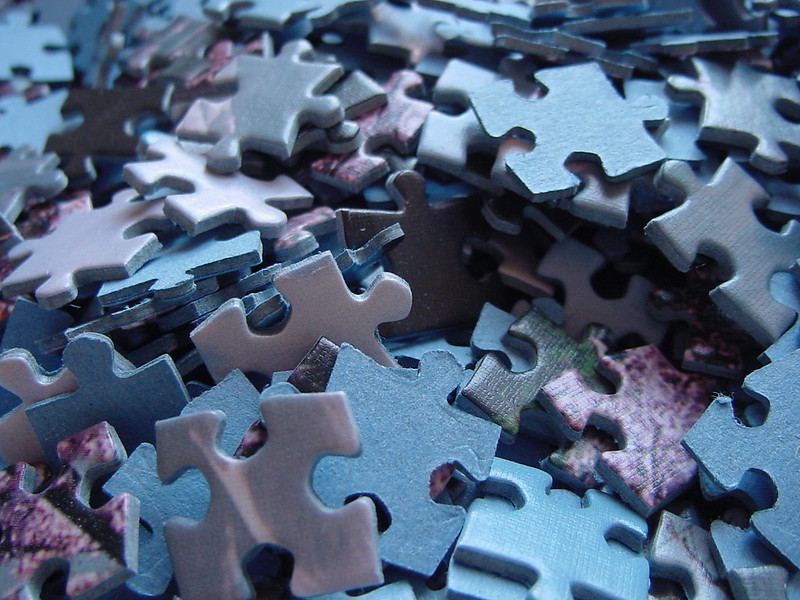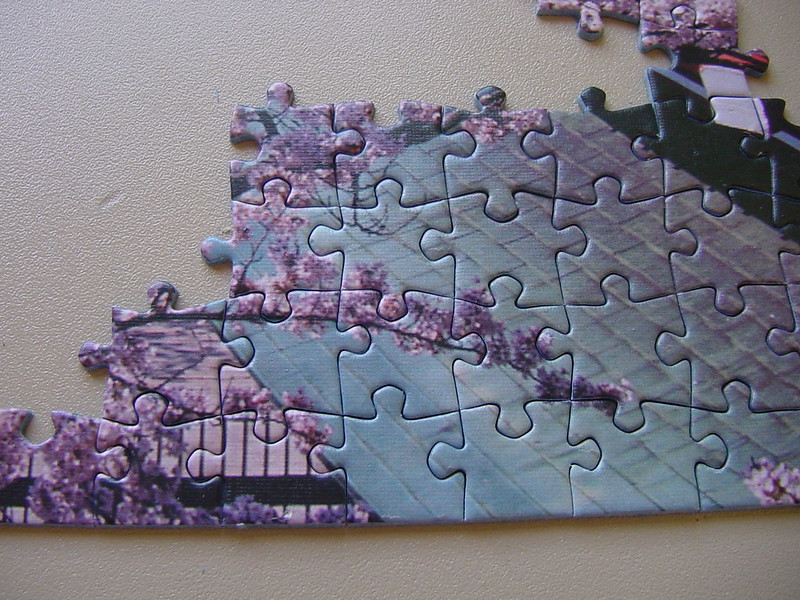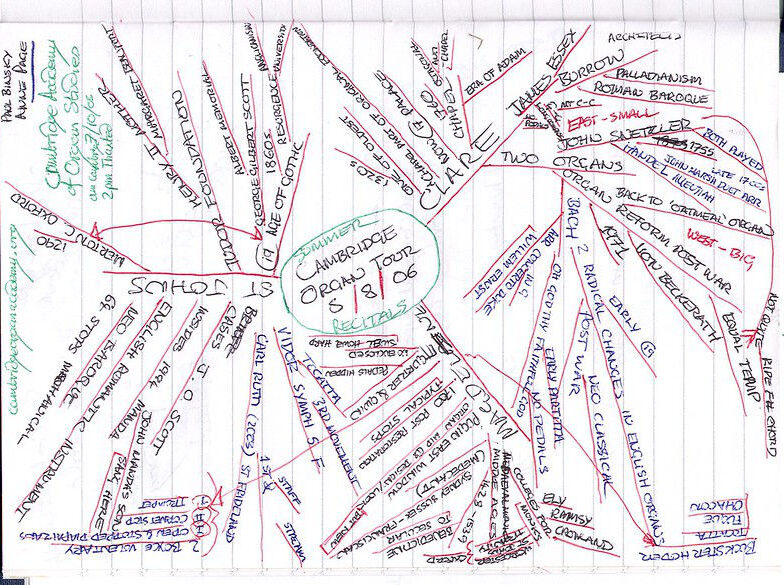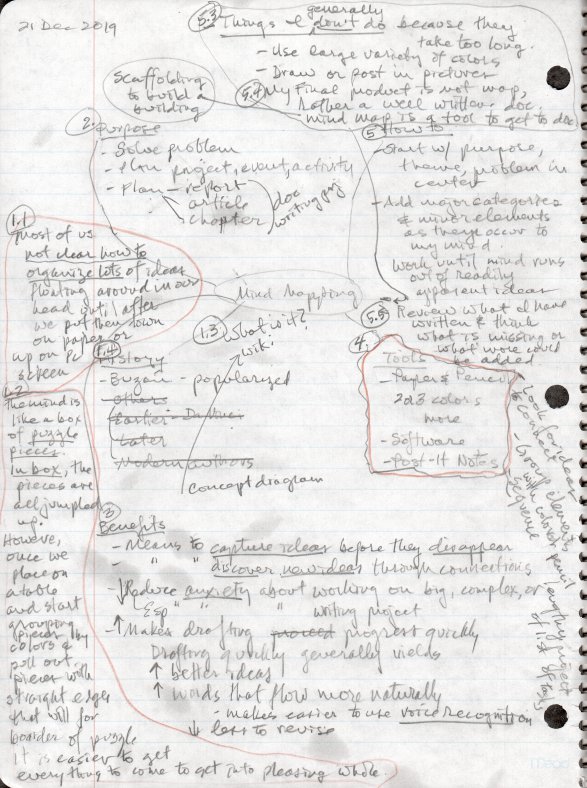Last Updated on 28-Mar-2023 by Charles Maxwell

When faced with preparing a document or presentation, you might be unsure how to start and how to proceed. You may have too many ideas bouncing around in your head. What helps is to put your ideas down on paper or up on a computer screen. There is a tremendous benefit to doing this. And, the best way to do this is by making a mind map.
1. What Is A Mind Map?
The mind is like a box overflowing with puzzle pieces—all jumbled up.

However, once we place puzzle pieces on a table, group them by color, and pull out the pieces with straight edges (which will form the border), the puzzle becomes more manageable. Organizing the pieces helps us get started.

Mind mapping is a method for making notes. A typical mind map resembles a neural web. It has lots of words radiating out from a central theme with lines connecting words and the word summarizing ideas. Here is an example.

Mind maps help capture and preserve thinking. They foster insight and promote innovation. Mind maps enable us to assemble concepts, thereby using what we know and discovering new meaning.
People have been organizing ideas graphically for a long time, but Tony Buzan popularized the concept of mine mapping during the 1970s. Today, it is widely used. And there are many different ways of doing it.
2. Why Make Mind Maps?
Mind maps help:
- Capture ideas before they disappear
- Connect ideas
- Discover new ideas
- Solve problems
- Plan projects and events
- Prewrite reports, articles, and chapters
When starting on something new, neurons in the brain fire in all directions. This is true when you start a new writing project. You just do not know where to begin, what to write. Making a map can help you capture elusive ideas and organize confusing concepts.
Once on paper or on a computer screen, you can find relationships—connect ideas, group them, arrange them, and sequence them. As you do, you will see new things—sometimes startling revelations.
Capturing your ideas can reduce the anxiety of starting work on a complex or lengthy project. When feeling uneasy about working on a challenging assignment, a mind map can restore confidence. It will allow you to see a way to move ahead amidst so much uncertainty.
A good mind map enables a writer to keep on task. Always having the reader in mind and focusing on the theme are difficult. A mind map keeps the central topic front and center.
When mind mapping, grouping ideas and linking concepts keeps the writer organized. It provides the writer better ideas—ideas that are more insight, ideas that connect with one another, and ideas that support the theme. With the ideas better organized, the words come out better.
A good mind map also leads to quicker drafts. With a map, the writer has the ideas for the draft right at hand. The writer can construct sentences more rapidly. This makes sentences sound more natural. Consequently, the draft is better, and the writer does not have to revise it as much. This also makes it easier to use voice recognition software, since the apps work better when the speaker talks at a steady speed and does not pause again and again looking for what to say.
3. Tools for Mind Mapping
While many types of mind mapping apps and programs exist, for me, the best tools are the simplest. Consequently, I prefer paper and pencils. Here is the mind map I made before drafting this article. It is nothing to brag about, but it worked—it got my ideas down on paper and helped we start drafting.

Some people make effective use of Post-it notes. They are especially good when working in a group. I discuss this in my post on brainstorming.
Software is another approach. Some of the more popular programs include:
- Ayoa by OpenGenius
- MindManager by Mindjet
- MindMapper by SimTech
- MindView by MatchWare
- Visio by Microsoft
These are just a few of the more than 240 active programs listed by Mind-Mapping.org. In addition, Wikipedia compares features of the major mind mapping software.
4. My Approach to Mind Mapping
Here is how I typically construct a mind map when working on a writing project:
- I start with my purpose, theme, or problem, and I place it in the center of a piece of paper
- I add major categories and minor elements as they occur to my mind
- I write a few words to capture each ideas—sometimes I write out a whole paragraph, if it just wants to come
- I work until my mind runs out of readily apparent ideas
- I work as quickly as possible
- Consequently, I do not use colors, and I rarely draw pictures
- I do not worry about making an pretty map, because my map is not my final product, rather, it is merely a tool I use to advance my writing projects in the same way that construction workers use scaffolding to build a building
- When I run out of ideas, I review what I have written and think what might be missing or what more I might add
- I then look for ideas to connect and group, perhaps using a pencil of a different color
- Finally, I sequence the elements by adding numbers
- During the sequencing, I think how to create a hook (an interesting first sentence or paragraph that will grab the reader’s attention)
- I also consider how best to end the document

5. Examples of People Making Mind Maps
Here are good examples of people making mind maps. You will benefit from seeing how they turn their ideas into words and diagrams.
Hazel Wagner
In the following video, Hazel Wagner does a wonderful job summarizing why and how to use mind mapping to take notes or prepare materials for a talk.
Here is a summary of Wagner’s presentation:
| 0:20 | Explanation of the benefits of mind mapping—advantages include learning, storing, and retrieving information better |
| 2:12 | Example of a simple, handwritten mind map—Wagner says it is better for most people to work “with a plain piece of paper and a pencil or a pen” |
| 2:48 | Guide to building maps—place the topic in the center, and then build out radially |
| 4:00 | Example of a computer-generated mind map |
| 5:10 | Comparison of mind maps to workings of the brain |
| 6:38 | Continuation of recommended method to build mind maps—use a piece of paper oriented horizontally, write down key words and short phrases, and connect ideas with lines |
| 8:48 | Example of mind map summarizing a TED talk by Dan Barber discussing ecological fish farming |
| 11:05 | Example of mind map summarizing a TED talk by Ken Robinson regarding creativity in schools |
Indiashastra
In the following video, the narrator does a good job demonstrating how to use mind mapping to take notes.
Peter, the Artist
In the following video, Peter, an artist, uses mind mapping to capture his train of thought. In doing so, he effectively illustrates how to represent ideas with words. His final mind map is a minor work of art. Few of us are as artistic as Peter, but we can profit by using the technique he demonstrates to capture our thoughts. In making his map, Peter has fun—all of us can copy his zest. He explains that mind mapping can help deal with mental overload, especially when setting goals.
Peter Feysa
In the following video, Feysa explains how a mind map mimics how the brain thinks. He shows how to use a mind map to make a personal plan.
Anna Sofia Ornberg
In the following video, Ornberg shows how to use mind mapping to summarize the contents of a book. In her case, she created a mind map covering the first 5 pages of the Hunger Games.
Conclusion
The next time you have a writing assignment, try mind mapping. Use it to:
- Define your theme
- Take research notes
- Plan your document
With a little practice, mind maps will make your work progress faster and yield better results.
Here is my advice on how to do it:
- Keep your maps simple, and make them fast
- Use a pencil
- Add only the simplest pictures
- Write as quickly as possible—for me this is writing in cursive
- Start with the main theme circled in the center
- Add branches moving out from center
- Connect ideas and group related ideas
- After the storm, sequence idea groups, and then sequence individual ideas within each group
Photo Credits
Image of indecision, photographer Elina Krima, Pexels, 3317936.
Photo of puzzle, photographer Olga Berrios, Flickr, 2719742541, https://www.flickr.com/photos/ofernandezberrios/2719742541, accessed 27 Dec 2019, used under creative commons license 2.0.
Photo of puzzle, photographer Olga Berrios, Flickr, 2719764089, https://www.flickr.com/photos/ofernandezberrios/2719764089, accessed 27 Dec 2019, used under creative commons license 2.0.
Photo of mind map, “Cambridge Organ Tour Mindmap,” photographer Tim Regan, uploaded 8 Aug 2006, Flickr, 210115701, https://www.flickr.com/photos/dumbledad/210115701, accessed 21 Dec 2019, used under creative commons license 2.0.
Photo of scaffolding, “scaffold,” photographer tommy, Flickr, 2115010957, https://www.flickr.com/photos/liketearsintherain/2115010957, accessed 21 Dec 2019, used under creative commons license 2.0.
Video Credits
“Want to learn better? Start mind mapping | Hazel Wagner | TEDxNaperville,” YouTube video, posted by TEDx Talks, 13 Dec 2017, https://youtu.be/5nTuScU70As.
“How I take Notes ☆ Mind Mapping Method ☆ How to Make Mind Map | Note Making,” YouTube video, posted by INDiASHASTRA, 10 Jul 2019, https://youtu.be/u1TZY9qvfHM.
“Mind Map to Success: The Peter Draws Method,” YouTube video, posted by Peter Draws, 5 Oct 2019, https://youtu.be/OBC6Av2PbKU.
“How to Create a MIND-MAP Tutorial,” YouTube video, posted by Peter Feysa, 9 Sep 2016, https://youtu.be/Jb3LJNSycaM.
“Mind Mapping Examples and Explainations [sic],” YouTube video, posted by CollegeStudentMatt, 22 May 2012, https://youtu.be/iSJ0DuDHL5Q.
“How to Take Notes with a MindMap,” YouTube video, posted by Anna Sofia Ornberg, 22 Nov 2012, https://youtu.be/J-yREy90FCc.